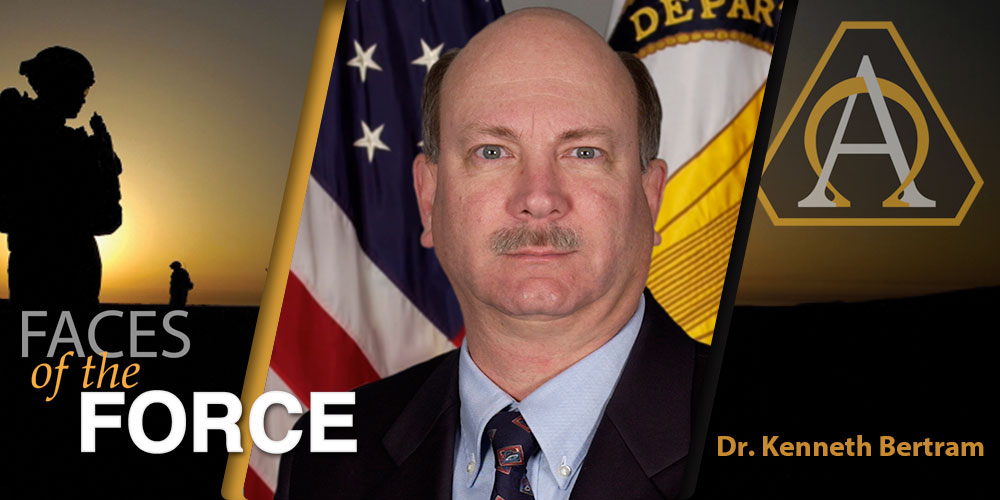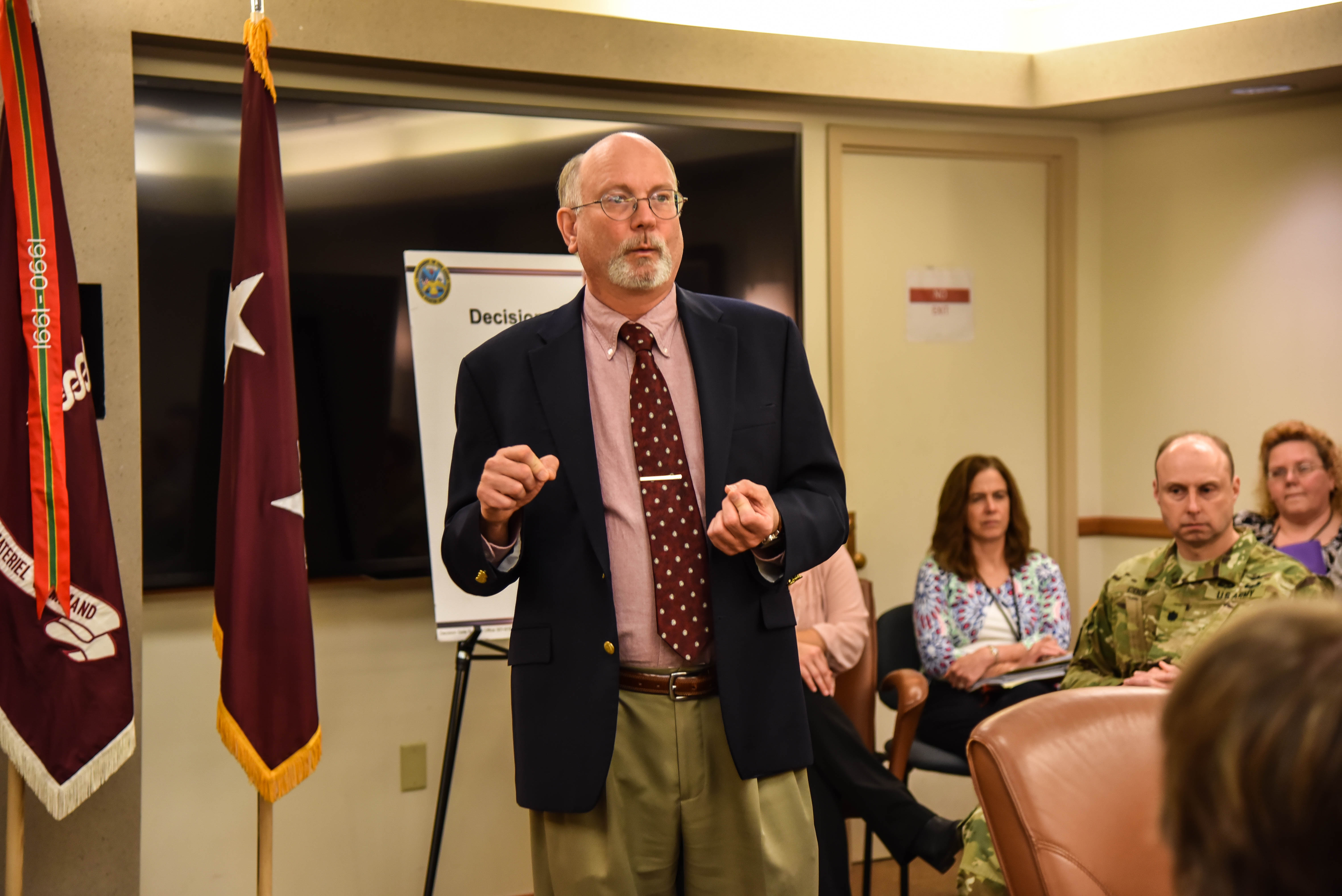
COMMAND/ORGANIZATION: U.S. Army Medical Research and Materiel Command, U.S. Army Medical Command
TITLE: Principal assistant for acquisition
YEARS OF SERVICE IN WORKFORCE: 8
YEARS OF MILITARY SERVICE: 24
DAWIA CERTIFICATIONS: Level III in program management and in science and technology management
EDUCATION: M.D. and Ph.D. in microbiology, University of Minnesota; B.S. in microbiology, University of Illinois at Urbana-Champaign
AWARDS: Decoration for Exceptional Civilian Service; Meritorious Civilian Service Medal; Superior Civilian Service Medal; Legion of Merit; Order of Military Medical Merit; U.S. Army Meritorious Service Medal; U.S. Army Commendation Medal
By Ms. Susan Follett
Ask anyone in acquisition what they’d change if they were king for a day, and the answers abound. Most hew toward minimizing or eliminating hurdles that slow the contracting and acquisition process, and debate rages over which are the highest of those hurdles. For Dr. Kenneth A. Bertram, principal assistant for acquisition for the U.S. Army Medical Research and Materiel Command (USAMRMC), that question is far less pressing than what must remain constant.
Bertram pointed out that acquisition at USAMRMC differs from the usual Army process in that the medical research laboratories, advanced development and logistics teams, as well as contracting, are all under a single commanding general, Maj. Gen. Barbara R. Holcomb, and a single milestone decision authority, Bertram. In fact, he noted, USAMRMC already looks much like the cross-functional teams that will be a key part of the Army modernization command spelled out by Army leadership and slated to debut later this year.
“I agree with others that our requirements and contracting process and our ability to partner with industry must be improved,” he said. “But I don’t consider the MRMC acquisition processes for ACAT III programs—in marked contrast to ACAT I or II programs, which MRMC does not have—overly burdensome. Our product and program managers would probably say we should get rid of AOAs [analyses of alternatives] or market studies, but I think all of those things are necessary to what we’re doing.”
The mission of USAMRMC’s Office of the Principal Assistant for Acquisition and its advanced development product and support teams is to develop, transition and field medical materiel solutions to optimize readiness and to protect, care for and heal the warfighter. “As principal assistant for acquisition, I lead those product teams and integrate the warfighter’s needs, the military’s acquisition procedures, the U.S. Food and Drug Administration’s regulatory requirements and our academic and industry partners’ processes, to provide sustainable solutions,” Bertram explained. “The greatest satisfaction of this position is providing the warfighter or warfighter medic with a new capability—a battlefield oxygen generator, for example, or new protection, such as the ability to rapidly diagnose an infectious disease.”

Dr. Kenneth Bertram addresses the workforce during the 2016 Decision Gate Awards ceremony USAMRMC headquarters at Fort Detrick. (U.S. Army photo by Crystal Maynard, USAMRMC)
Therein lies his focus as an acquisition professional—that which never changes, the “true north” of Army acquisition. Keeping warfighter needs, capability gaps and solutions “as the ‘true north’ is necessary to avoid becoming trapped in changing resource environments, mission drift and other people’s agendas,” he said. Bertram spent 24 years in the Army, retiring in 2009 and becoming a member of the Senior Executive Service in July of that year. Having served in leadership positions throughout his active-duty career, he’s well-versed in the problems that warfighters face in the field and in garrison, and that knowledge “enables USAMRMC to focus on developing the solutions that are needed in a prioritized fashion,” he said.
Anyone in his position needs two skills, he said: the ability to listen and the ability to make a decision. “You won’t ever get all the information you need, but you have to make a decision: You can’t flounder in the land of indecision.”
He got his start in acquisition when he was recruited in the late 1990s to serve as the deputy director for Congressionally Directed Medical Research Programs at Fort Detrick, Maryland, managing an annual budget of roughly $200 million in research, development, test and evaluation funds. “While those funds were primarily to support extramural or university research in cancer—at the direction of Congress—the funds and research needed to be managed according to DOD acquisition regulations and processes. So, I began work toward Level III certification in science and technology management. I transitioned to a greater product development focus—especially for drugs and vaccines—as a result of my command time at the Walter Reed Army Institute of Research, and earned Level III certification in program management.”
He started in his current role in 2009. “When I started, I noticed that our staff had much of the training and certification they needed. But what I didn’t realize is that many had gotten that training a long time ago. What they learned wasn’t applicable to the way we do contracting now, or they worked in just one area and weren’t well-versed in how other processes worked. We spent a lot of time getting our staff the right training.”
The other challenge he faced was demonstrating to stakeholders the importance of USAMRMC’s work. “We’ve spent a lot of time with [the assistant secretary of the Army for acquisition, logistics and technology], the G-8, the House and the Senate, getting them to understand the value of what we do,” he said. “We’ve walked people through the process of using our products as if they were a recruit, on the battlefield or recovering from injury, to demonstrate how our products work and how they help the warfighter.”
Keeping an eye on true north is good for the career, too. “If you succeed on behalf of the warfighter, career opportunities will present themselves abundantly.”
He also noted the importance of career-broadening opportunities, networking with other services, agencies and industry, and completing required and recommended acquisition training. “Lead something,” he said. “Solutions for the warfighter only happen when someone provides initiative, responsibility and direction. Let that someone be you.”
“Faces of the Force” is an online series highlighting members of the Army Acquisition Workforce through the power of individual stories. Profiles are produced by the U.S. Army Acquisition Support Center Communication and Support Branch, working closely with public affairs officers to feature Soldiers and civilians serving in various AL&T disciplines. For more information, or to nominate someone, please contact 703-664-5635.
Subscribe to Army AL&T News, the premier online news source for the Acquisition, Logistics, and Technology (AL&T) Workforce.







